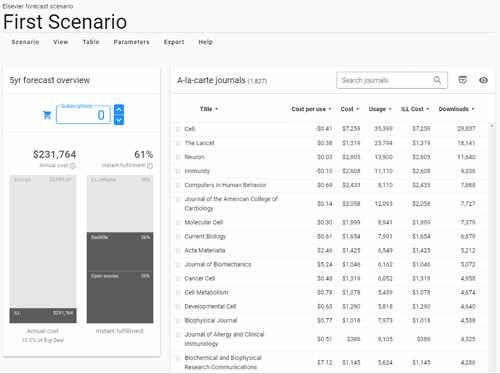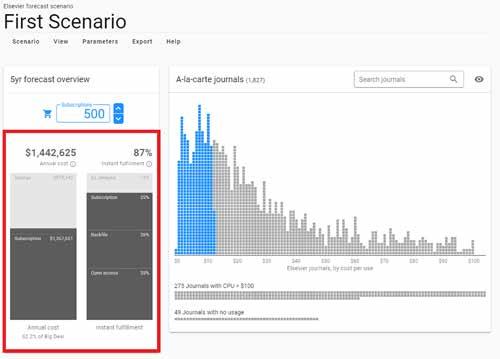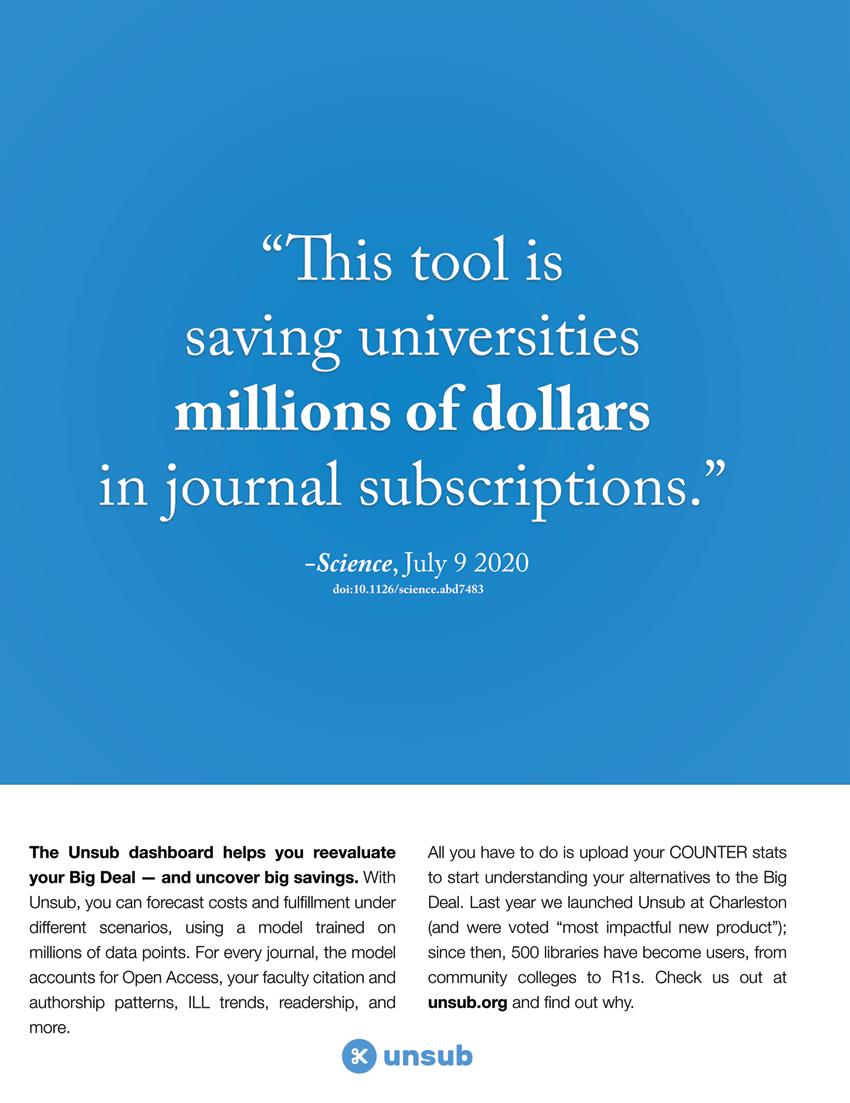
10 minute read
Unsub
ADVISOR REVIEWS—STANDARD REVIEW Unsub
doi:10.5260/chara.22.2.55
Composite Score: HHHH 1/4
Reviewed by:
Grant Hardaway Trinity University, San Antonio, Texas
Abstract Unsub is a browser-based decision making tool made for an academic library’s journal collection management team. The interactive data dashboard organizes journals by a carefully calculated cost per use number and allows users to visualize the potential savings of journal cancellations. While not comprehensive in its publisher coverage, Unsub effectively streamlines a typically arduous process.
Pricing Unsub uses a yearly subscription model. The product provides a tiered pricing system based on the amount of a library’s materials budget. A yearly subscription ranges from between $500 for libraries with a materials budget between $0 and $500,000 to $3,000 for budgets that are $2,500,000 or more.
If a consortium subscribes to Unsub, each institution is provided with a 10% discount on their subscription. At no additional cost, the consortium administrator will be provided with a personalized data dashboard that displays the data for the entire consortium.
Our Research does provide the open source code for Unsub through GitHub (<https://github.com/ourresearch/get-unsub>). Date of Review: September 1, 2020
<ghardawa@trinity.edu>
Overview Unsub is a browser-based decision making tool made for an academic library’s journal collection management team. The tool was created by the small non-profit organization Our Research in late 2019. Formerly known as Unpaywall Journals, Unsub was developed as a response to the complex decision making process necessary to assess the value of journal publishers’ Big Deal packages. Unlike Our Research’s open projects, such as Unpaywall and Impactstory Profiles, the Unsub service is solely supported by user subscriptions.
Through a data dashboard, Unsub allows users to forecast potential journal cancellation and subscription decisions. COUNTER data is sent to the Unsub team and they create a personalized dashboard based on that data. Institutions may also send in their Backfile data and pricing lists to further personalize the data set. But, the only data that is necessary to create the dashboard is the institution’s COUNTER data. If institutions subscribe at the consortium-level, Unsub also provides a free consortium dashboard that compiles the data from all participating institutions.
The goal of Unsub is to simplify the difficult process of evaluating the losses and savings of unsubscribing from a journal. The interactive dashboard organizes journals by a calculated cost per use (CPU)
FIGURE 1 Dashboard Unsub’s Histogram
FIGURE 2 Dashboard Unsub’s Table
and allows users to visualize the potential savings of journal cancellations. Significantly, the CPU calculation factors in data from a journal’s Open Access content (via Unpaywall), estimated ILL costs if the institution unsubscribes, and faculty authorship and citations within that journal (via Microsoft Academic Graph). After selecting which journals to subscribe to à la carte, the projected costs are then evaluated as a percentage of the cost of a publisher’s Big Deal.
User Interface When generating a data dashboard, users must first select which journal publisher they want to analyze. At the time of writing this review, Unsub only provides data dashboards for journals published by Wiley, Elsevier, and Springer Nature. Per e-mail correspondence with the Unsub team, other publishers will potentially be added later in 2020.
Once a publisher is selected, users click New Scenario to generate a data dashboard of the journals from that publisher. The dashboard displays a sorted list of journals created from the institution’s COUNTER data, subscription history, and price lists. At the journal-level, users can toggle the display of the list of journals as either a histogram or table. The histogram display assorts journals by CPU. The table display can assort journals by a variety of factors including CPU, estimated ILL cost if the institution does not subscribe, number of downloads, and many more parameters (see Figures 1 and 2).
For an overall forecast, the dashboard includes a stacked bar chart for the annual cost of the subscriptions and the percentage of articles that can be instantly accessed. The annual cost is calculated as a combination of subscription cost and estimated ILL cost.

The annual cost is also measured as a percentage of the Big Deal cost for that publisher. The percentage of instant fulfillment is calculated from a combination of subscription-based access, Open Access, and backfile access (see Figure 3).
While the dashboard is based on what the institution initially sends to Unsub, data parameters can be customized within the forecast itself. Via the Parameters tab, users can customize ILL cost, Big Deal cost, the percentage of yearly subscription cost growth, and various other factors. A significant customizable parameter is the weight of an in-

FIGURE 4 Unsub’s Journal-Level

stitution’s citations and authorship for a journal. For instance, each faculty citation could be set to the equivalent of 10 article downloads while each faculty authorship could be set to 100 downloads. By customizing the weight of these factors to an institution’s needs, the true CPU value of a journal can become clearer.
When a user clicks on an individual journal data entry, they will be able to view a breakdown of its annual usage and cost. Annual usage includes the subscribing institution’s faculty citation rate and authorship. Annual usage also takes into account the availability of Open Access articles and backfile access. In addition to the base subscription cost, the annual cost provides an estimate of the 5-year ILL cost of unsubscribing to a journal (see Figure 4).
Once assessing these parameters, users can begin to select their journal subscriptions. Users can either have Unsub automatically select journals based on the CPU calculation (e.g., choosing 500 subscriptions will select the top 500 best CPU journals) or users can select each journal individually. Unsub provides a search bar to find specific journal subjects or titles for selection. Each time a journal is selected for subscription, the overall forecast is updated to include the new costs.
Once finished with a forecast, there are various ways Unsub allows users to export their data. In order to share the results of a forecast with interested parties, Unsub provides a publicly viewable version of the dashboard. Forecasts can also be exported as a spreadsheet. The dashboard also includes API support by generating a personalized API key for the data set.
Critical Evaluation Unsub streamlines a typically arduous process for collection management teams. The user-friendly interface allows teams to interact with multiple data points to make well-informed decisions. By generating an easily readable and customizable forecast, teams can clearly report to administrators, faculty, and colleagues the cost savings of journal cancellations.
Unsub provides more than just a visually appealing dashboard. The inclusion of Open Access into the equation of instant fulfillment for articles provides an extra layer of analysis that many teams may not
Analysis
be able to easily consider on their own. While a dashboard of this data could be created in-house, Unsub makes the process simple, effective, and relatively stress-free allowing teams to focus on the more pressing matter of budget management.
With a relatively low yearly subscription cost, Unsub would not be a significant burden on the library budget, especially if it ends up helping them save money. The COVID-era has trimmed library budgets at an even faster rate than in the past for many universities. Unsub would be a very helpful tool to assist with the many difficult budget decisions that need to be made for libraries across the United States.
At the time of writing this review, Unsub currently only provides forecasts for journals provided by Wiley, Elsevier, and Springer Nature. While the current options are some of the largest academic publishers, the lack of other major publishers such as Taylor & Francis and SAGE are significant blind spots. Depending on a library’s cancellation needs, not having access to other publishers’ information could lessen the value of an Unsub subscription.
While using a simple design, Unsub does not include some basic ADA components such as text resizing. The site design does provide ample headings and labels for each item. While not egregious, these design considerations could have an impact on a users’ utility of the tool.
Access to Unsub was consistent and reliable. While no issues arose during the review, Unsub’s help team was very responsive. Throughout the writing of this review, I was regularly provided with prompt answers to my questions.
Since this review was based on the Demo version of Unsub, the efficacy and efficiency of translating an institution’s COUNTER data into a personalized dashboard was not observed. Based on the Unsub discussion forums (“Unsub Discuss”) and other reviews (Chawla 2020), there were no reports of difficulty with the data transitioning into the dashboard.
Freetext Keywords: collection management | academic journal | data visualization | academic library | budget management | Open Access | Big Deal
Primary Category: Library and Information Science (LIS)
Review Type(s): Library tool
Target Audience: Secondary
Access Type(s): Subscription
Unsub Review Scores Composite: HHHH 1/4
The maximum number of stars in each category is 5.
Content: HHH 1/2 Unsub currently provides analyses for three of the major publishers, Elsevier, Wiley, and Springer Nature. While a good starting point, Unsub will need to add more publishers to become a comprehensive tool for collection management teams.
User Interface/Searchability: HHHH Interface is clean, customizable, and user-friendly. The overall design lacks some basic ADA features such as text resizing.
Pricing: HHHH 1/2 The tiered pricing of Unsub is very reasonable. The value to institutions will vary depending on how many cancellations they plan on making to their subscription packages.
Purchase/Contract Options: HHHHH Simple, non-intrusive contract that retains the ownership of a user’s data and their privacy.
Competitive Products At the time of this review, there are no available competitors to Unsub. Depending on the UX experience of a team, they could create a similar data dashboard with their COUNTER data using most data visualization software available such as Tableau or Google Analytics. Ultimately, the value of Unsub is the work the team does in the background to create the dashboard.
Purchase Contract Under Unsub’s Terms & Conditions (2020), an institution retains all ownership rights to their various journal data sets. This data will only be used by Unsub for the creation of the data dashboard.
Authentication Unsub uses standard username and password authentication. No IP filtering is used.
Author’s References Chawla, Dalmeet Singh. “This Tool Is Saving Universities Millions of Dollars in Journal Subscriptions.” Science, July 9, 2020. <https:// doi.org/10.1126/science.abd7483> Hinchliffe, Lisa Janicke. “Taking a Big Bite Out of the Big Deal.” The Scholarly Kitchen, May 19, 2020. <https://scholarlykitchen.sspnet. org/2020/05/19/taking-a-big-bite-out-of-the-big-deal/> Contact Information
Our Research
E-mail: <team@ourresearch.org> Producer URL: <https://ourresearch.org/> Product URL: <https://unsub.org/>
Our Research. “Unsub.” Accessed August 14, 2020. <https://unsub. org/> “Terms & Conditions.” Unsub, June 16. 2020. <https://unsub.org/unsub-toc.pdf> “Unsub Discuss.” Google Groups. Accessed August 14, 2020. <https://groups.google.com/g/unsub-discuss>
About the Author
Grant Hardaway is the Instruction Librarian for the Sciences at Trinity University in San Antonio, TX. At Trinity, Grant manages the science collection and provides students and faculty with information literacy instruction and research consultations. His scholarly interests focus on the Open Science movement and Open Access awareness. When not helping patrons, Grant enjoys watching movies on the Criterion Channel and playing with his cat Disko. n


A New Type of Review Journal
Cold Spring Harbor Perspectives in Biology is a new monthly online publication. Spanning the complete spectrum of the molecular life sciences, the journal offers article collections that comprehensively survey topics in molecular, cell, and developmental biology, genetics, neuroscience, immunology, cancer biology, and molecular pathology. Written by leading researchers and commissioned by an eminent board of editors, subject collections grow with every issue of the journal. Cold Spring Harbor Perspectives in Biology is thus unmatched in its depth of coverage and represents an essential source for informed surveys and critical discussion of advances in emerging areas of biology. Scope: Molecular Biology, Cell Biology, Developmental Biology, Genetics, Immunology, Neurobiology Monthly, online ISSN: 1943-0264
Subject Coverage Angiogenesis Antigen Processing Apoptosis Auxin Signaling Calcium Signaling Cell–Cell Junctions Cilia and Flagella The Cytoskeleton DNA Damage and Repair The Extracellular Matrix The Endoplasmic Reticulum The Evolution of Gene
Networks Generation and Interpretation of Morphogen Gradients Germ Cells The Golgi Apparatus Growth Factor Receptors Immune Cell Signaling Immune Tolerance Lipid Cell Biology Lymphocyte Cell Biology Mammary Gland Biology Mechanotransduction Membrane Fusion and
Exocytosis

Mitochondria Mitosis Molecular Motors Muscle Cell Biology Neuronal Guidance The NF-� B Family Nuclear Hormone Receptors The Nucleus The Origin of Life The p53 Family Prions Prokaryote Cell Biology Protein Homeostasis Receptor Tyrosine Kinases Recombination Mechanisms Regeneration RNA Worlds Sex Determination Symmetry Breaking in
Biology Synapses Transcriptional Regulation Wnt Signaling The Y Chromosome









